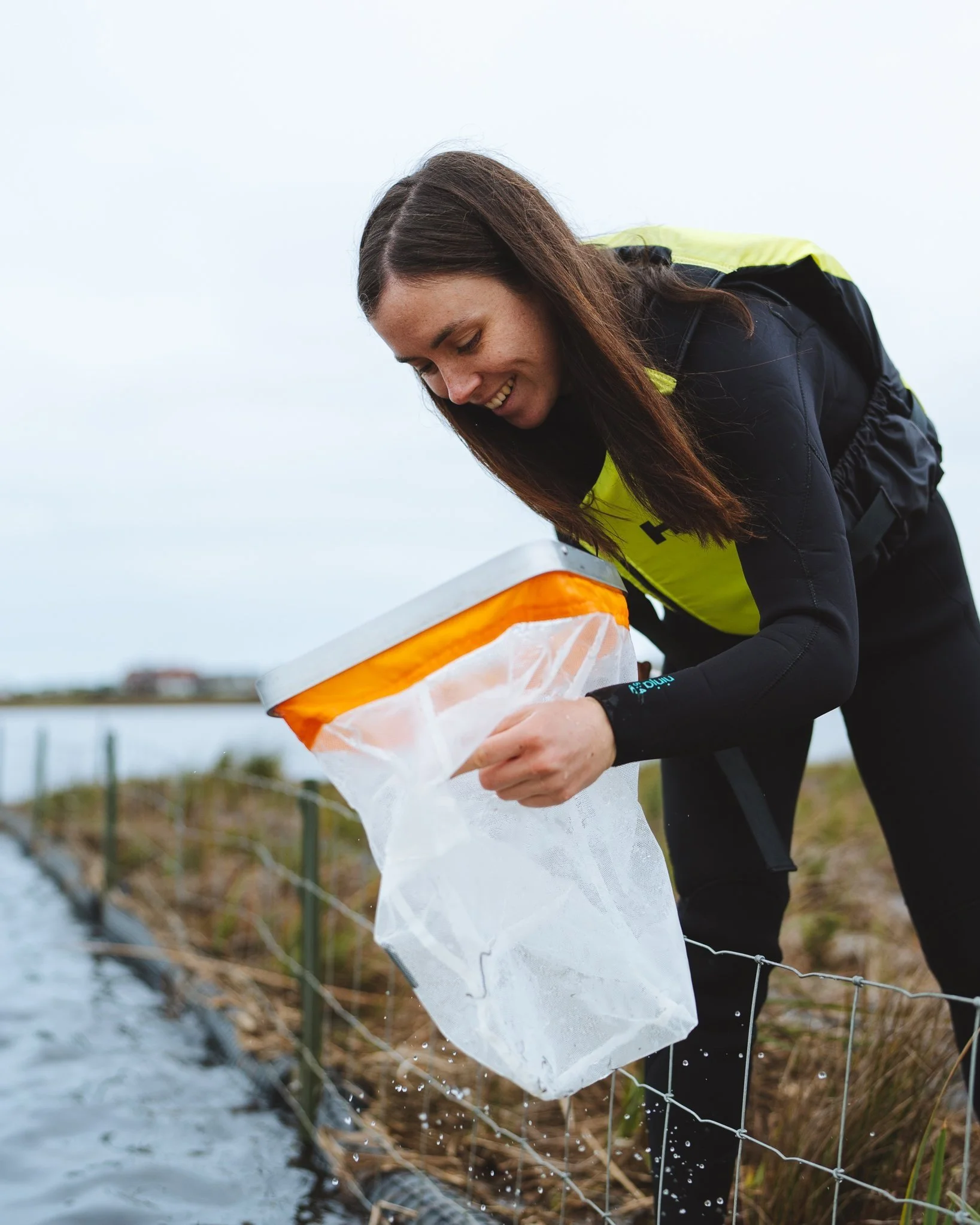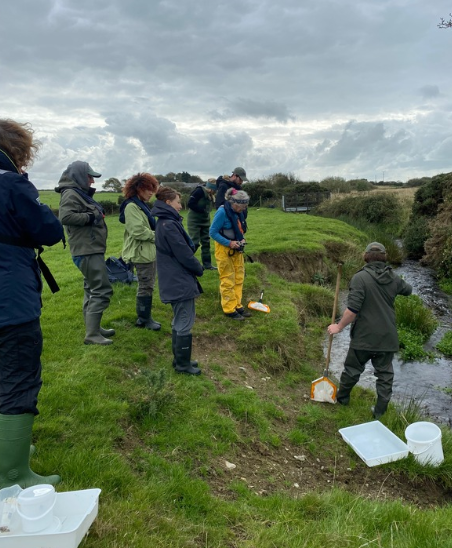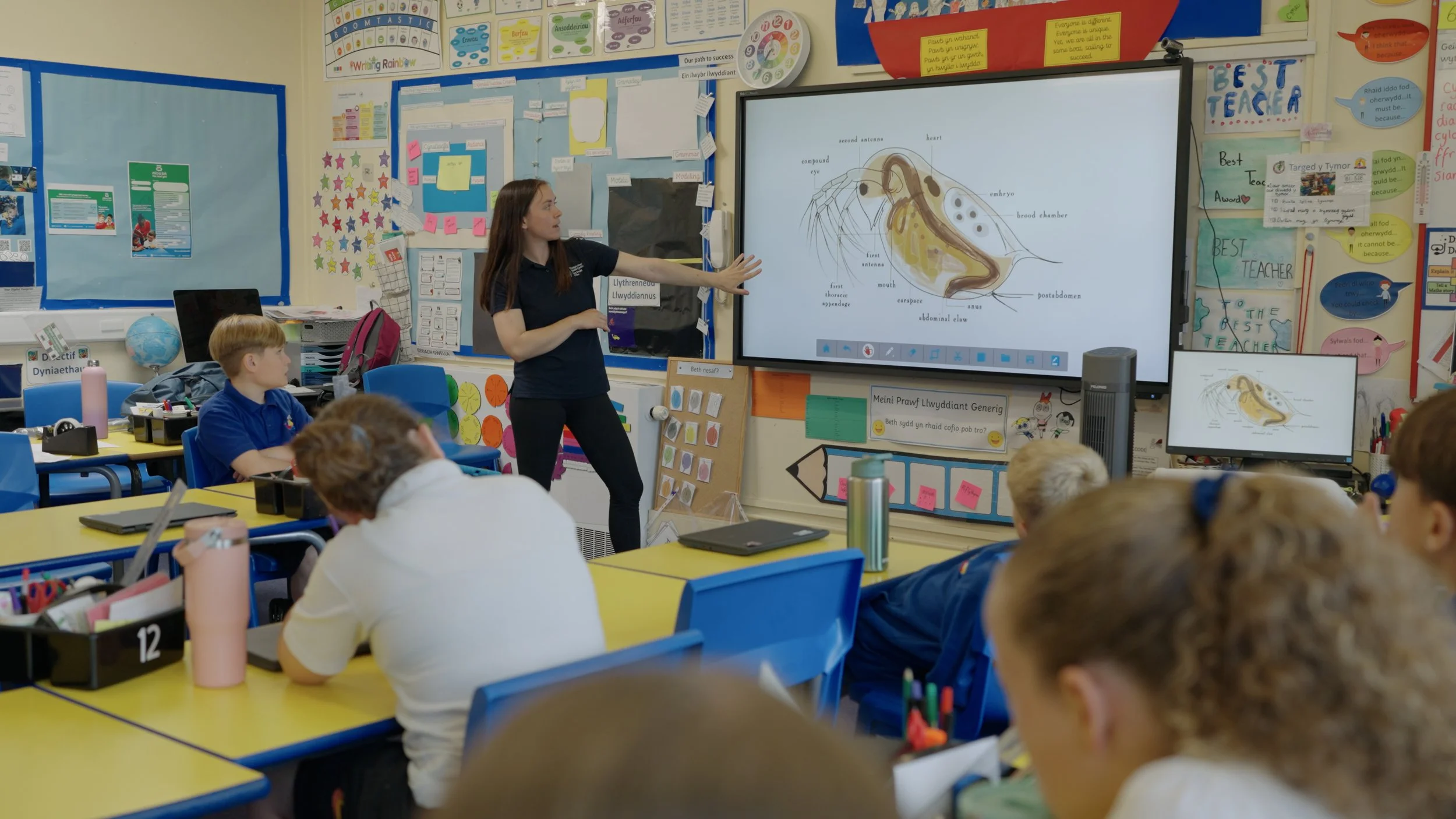
Floating Wetlands
This project is funded by Welsh Government’s Local Places for Nature Challenge Fund, administered by WCVA.
A pilot study across three Ynys Môn lakes
the pilot
In partnership with Ynys Mon Local Nature Partnership program, we are conducting a pilot study involving three lakes to better understand the impact of floating wetlands on water quality and the mitigation of harmful algal blooms. This study includes:
Control Lake: This lake is equipped with sondes that monitor nutrient levels but has no floating wetland installed. It serves as a baseline to compare the effectiveness of the interventions in the other lakes.
Lake with Floating Wetland: This lake has a floating wetland installed to absorb nutrients directly from the water, aiming to reduce the nutrient load and control algal blooms.
Llyn Maelog: This lake not only has a floating wetland but also additional upstream interventions designed to reduce nutrient inputs from agriculture and sewage. These combined efforts aim to tackle the nutrient pollution at its source and further enhance the effectiveness of the floating wetland.
We are hoping the learnings from this study will help to inform design and planning for future floating wetlands to support biodiversity and water quality.
Cyanobacteria can become a problem in lakes like Llyn Maelog under certain conditions, leading to harmful algal blooms (HABs) that produce toxins dangerous to humans and animals, including dogs. Here are the conditions that can contribute to cyanobacterial problems in such lakes:
Nutrient Enrichment (Eutrophication): Excessive nutrients, particularly nitrogen and phosphorus, from agricultural runoff, sewage, and other sources can lead to nutrient-rich waters that promote the growth of cyanobacteria.
Warm Temperatures: Cyanobacteria thrive in warm water temperatures, typically during late spring to early fall. Higher temperatures accelerate their growth and bloom formation.
Calm Water Conditions: Still or slow-moving water provides an ideal environment for cyanobacteria to accumulate and form blooms. Windless days and limited water circulation contribute to these conditions.
Sunlight: Cyanobacteria need sunlight for photosynthesis, so prolonged periods of sunny weather can enhance their growth.
Water Chemistry: Certain chemical conditions, such as higher pH levels and low water hardness, can also favor cyanobacterial growth.
the problem
SAFE HAVEN FOR BIRDS:
Custom platforms designed to support bird nesting and resting.
The Benefits of floating wetlands
2. FLOATING WETLAND PLATFORM:
Floating wetland platforms are a no-waste, nature-based solution made from recycled, UV and oxidation-resistant materials.
3. THE ROLE OF PLANKTON AND BIOFILM:
Plankton and biofilm enhance nutrient absorption by working together to remove excess nitrogen and phosphorus from the water, creating healthier ecosystems for wildlife.
4. WETLAND PLANTS
Wetland plants provide protective cover for wildlife and help to filter out excess nutrients as part of the wetland’s floating ecosystem.
5. STRONGER FISH STOCKS:
Cleaner water and more diverse wetland habitats create better survival conditions for fish and more abundant stocks, while also reducing predation on swimming juvenile fish.
Collecting the Data
The pilot study is being evaluated through a combination of scientific monitoring and community involvement, in collaboration with Bangor University and our team of trained local citizen scientists.
Monitoring using sondes at Llyn Coron
Before installing the floating wetlands, we collected a wide range of baseline data from all three lakes included in the trial. This included measurements of water quality, nutrient levels, and biological indicators.
Using reliable data collection techniques like Sondes (constant water quality monitoring) the data collected has acted as a solid building point for accessing the impact of Floating Wetlands.
Freshwater Invertebrate Data
To understand the effect of Floating Wetlands on Freshwater invertebrate populations a monitoring programme has been set up looking at abundance and diversity of animals beneath the wetland in comparison to open water. The results so far suggest that the floating wetland is providing important habitat benefits, even during winter when invertebrate activity is typically low. The structure offers shelter, stable surfaces for attachment, and food sources that are largely absent in the open water column.
Smart River Hub
Alongside monitoring the lake, assessments of the tributaries flowing into the key lakes have been made by our team of citizen scientists who have been collecting data on invertebrate populations using the Smart River Hub methodology.
The volunteers collect and
identify samples twice yearly.
View the results here:
Water Quality Data
To understand the effect of Floating Wetlands on water quality and Blue Green Algae levels in particular our dedicated community volunteers have been collecting water samples from three points around Llyn Maelog on a weekly basis and sending the samples to an accredited lab to be analysed. These results are also shared weekly with the local community via our dedicated Facebook page.
2024 results
2025 results
As part of this pilot programme, we collaborated with teachers, educators, and students in Ynys Môn to help them create their own floating wetlands.
Developed in partnership with the Charles River programme and with support from the LNP team, WCVA, and the Welsh Government, the STEAM Activity Kit offers a hands-on opportunity to learn about the lakes' ecology, pollution, and water quality.
The booklet and lesson plans, designed for a four-week course for grades 3-6, include lessons and activities that fit within a one-hour period. The Activity Kits explore the lifecycle of daphnia and demonstrate changes in water when daphnia, spirulina, and a wetland are present in the same environment. This engaging and educational programme helps students understand the importance of maintaining healthy aquatic ecosystems and the role of innovative solutions like floating wetlands in water quality management.
education

“Our STEAM EDUCAtION PRoGRAMME INSPIRES YOUNG PEOPLE TO UNDERSTAND WATER QUALITY, POLLUTION AND NATURE BASED SOLUTIONS TO AID RECOVERY.”
— Poppy Backshall ,Community Engagement Officer



As part of our Floating Wetland Care Home Project, we partnered with local care homes to grow wetland plants. Our team visited residents to deliver hands-on gardening sessions, where together we nurtured native wetland species ready for planting.
These visits also became a space for connection, as residents shared their memories and stories of local rivers—adding a personal and intergenerational layer to the project. By combining environmental action with community care, the project brought people and nature closer together in a meaningful and restorative way.
Wetland care home project

faq’s
Protecting Ynys Môn lakes
-
Cyanobacteria, also known as blue-green algae, are a phylum of bacteria that obtain their energy through photosynthesis. Here are some key points about cyanobacteria:
Photosynthetic Ability: Cyanobacteria are unique among bacteria for their ability to perform oxygenic photosynthesis, similar to that of plants. This means they can convert sunlight into energy and produce oxygen as a byproduct.
Ecological Role: They play a crucial role in many ecosystems, particularly in aquatic environments, as primary producers. They form the base of the food web, supporting a variety of marine and freshwater life.
Nitrogen Fixation: Some cyanobacteria can fix atmospheric nitrogen into a form usable by plants and other organisms. This makes them important in nutrient cycling, especially in nutrient-poor environments.
Habitat: Cyanobacteria are found in a wide range of habitats, including freshwater, marine environments, moist soils, and even extreme environments like hot springs and desert crusts.
Historical Significance: They are believed to be one of the earliest forms of life on Earth, playing a significant role in the Great Oxygenation Event around 2.4 billion years ago, which dramatically increased the oxygen levels in the Earth's atmosphere.
Health and Environmental Impacts: While they are essential to ecosystems, some cyanobacteria can produce toxins known as cyanotoxins. These can be harmful to humans, animals, and the environment, causing issues like harmful algal blooms (HABs) in water bodies.
Applications: Cyanobacteria are also being explored for various applications, including biofuel production, bioremediation, and as sources of natural products like vitamins and pigments.
-
Cyanobacteria can become a problem in lakes like Llyn Maelog under certain conditions, leading to harmful algal blooms (HABs) that produce toxins dangerous to humans and animals, including dogs. Here are the conditions that can contribute to cyanobacterial problems in such lakes:
Nutrient Enrichment (Eutrophication): Excessive nutrients, particularly nitrogen and phosphorus, from agricultural runoff, sewage, and other sources can lead to nutrient-rich waters that promote the growth of cyanobacteria.
Warm Temperatures: Cyanobacteria thrive in warm water temperatures, typically during late spring to early fall. Higher temperatures accelerate their growth and bloom formation.
Calm Water Conditions: Still or slow-moving water provides an ideal environment for cyanobacteria to accumulate and form blooms. Windless days and limited water circulation contribute to these conditions.
Sunlight: Cyanobacteria need sunlight for photosynthesis, so prolonged periods of sunny weather can enhance their growth.
Water Chemistry: Certain chemical conditions, such as higher pH levels and low water hardness, can also favor cyanobacterial growth.
Potential Hazards
Toxins: Some cyanobacteria produce cyanotoxins, which can be harmful to animals and humans. Dogs are particularly at risk because they might drink contaminated water or lick cyanobacteria from their fur.
Liver Toxins: Such as microcystins.
Neurotoxins: Such as anatoxin-a.
Skin Irritants: Can cause rashes and other skin issues upon contact.
Symptoms in Dogs
Liver Toxin Exposure: Vomiting, diarrhea, jaundice, lethargy, seizures, and in severe cases, death.
Neurotoxin Exposure: Muscle tremors, difficulty breathing, paralysis, and death within minutes to hours.
Prevention and Mitigation
Monitoring and Reporting: Regular monitoring of water bodies for cyanobacterial blooms and reporting any sightings to local environmental or health authorities.
Public Awareness: Informing the public about the dangers of cyanobacteria, particularly pet owners who might let their dogs swim in or drink from the lake.
Nutrient Management: Implementing practices to reduce nutrient runoff into lakes, such as better agricultural practices, proper sewage treatment, and maintaining buffer zones around water bodies.
Water Treatment: In some cases, chemical treatments or aeration can help control cyanobacterial blooms, though these methods must be used cautiously to avoid further ecological disruption.
Immediate Actions if Exposure Occurs
Seek Veterinary Care: If a dog shows symptoms of cyanotoxin poisoning, immediate veterinary attention is crucial.
Rinse with Clean Water: Rinse the dog thoroughly with clean, fresh water to remove any cyanobacteria from their fur and skin.
Regular monitoring and proactive management are key to preventing and mitigating cyanobacterial problems in lakes like Llyn Maelog.
-
Floating wetlands, also known as floating treatment wetlands (FTWs), can be an effective method for mitigating cyanobacterial blooms in lakes like Llyn Maelog. Here’s how they work and their benefits:
How Floating Wetlands Work
Structure: Floating wetlands are constructed platforms made from buoyant materials that support a variety of aquatic plants. The roots of these plants extend down into the water column, creating a habitat for beneficial microorganisms.
Nutrient Uptake: The plants and their associated microbial communities absorb nutrients, particularly nitrogen and phosphorus, from the water. These nutrients are essential for cyanobacterial growth, so reducing their availability helps control blooms.
Habitat Creation: The roots and plant matter provide a habitat for microorganisms that can break down organic matter and further process nutrients, improving overall water quality.
Shade and Oxygenation: Floating wetlands provide shade, which can reduce water temperatures and limit sunlight penetration, both of which can inhibit cyanobacterial growth. Additionally, the plants can enhance oxygen levels through photosynthesis and root-zone aeration, which benefits aquatic life.
Benefits of Floating Wetlands
Nutrient Reduction: By absorbing excess nutrients, floating wetlands directly address one of the primary causes of cyanobacterial blooms.
Improved Water Quality: The reduction of nutrients and organic matter improves overall water quality, making the water body healthier for aquatic life and safer for human and animal use.
Biodiversity Enhancement: Floating wetlands create habitats for various organisms, increasing biodiversity within the water body. This can lead to more balanced ecosystems less prone to harmful algal blooms.
Erosion Control: By stabilizing shorelines and reducing wave action, floating wetlands can help prevent erosion, which also contributes to nutrient loading.
Aesthetic and Recreational Value: These wetlands can enhance the natural beauty of a lake, making it more attractive for recreational activities.
Implementation Considerations
Design and Placement: The design and placement of floating wetlands should be tailored to the specific conditions of the lake, such as water depth, flow patterns, and nutrient levels.
Maintenance: Regular maintenance is required to ensure the health and effectiveness of the plants. This includes periodic harvesting of plant biomass to remove accumulated nutrients from the system.
-
Opportunities for Participation
Wildlife Monitoring:
Observation and Recording: Community members can participate in observing and recording wildlife around Llyn Maelog, including birds, amphibians, fish, and macroinvertebrates.
Training Sessions: Attend training sessions to learn how to accurately identify species and record observations.
Water Quality Testing:
Citizen Science Kits: Volunteers can use simple water testing kits to measure parameters like nitrate, phosphate, and ammonia levels.
Workshops: Participate in educational workshops to learn water quality monitoring techniques and understand the significance of different parameters.
Regular Monitoring:
Sampling Assistance: Help scientists with weekly water sample collection.
Data Entry: Assist with entering data into the central database and maintaining records.
Data Analysis and Feedback:
Review Meetings: Join regular meetings to review collected data, discuss findings, and provide feedback.
Online Platform: Use the online platform or mobile app to upload observations and test results.
Awareness and Outreach:
Community Meetings: Attend community meetings to stay informed about the monitoring progress and results.
Public Communication: Help spread awareness by sharing updates through newsletters, social media, and local news outlets.
How to Get Involved
Contact Information:
Email Poppy at the North Wales Rivers Trust: poppy@northwalesriverstrust.org
Events Page:
Check our events page for updates on dates and opportunities to get involved.














